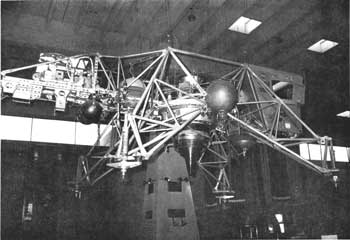.gif)
|
Man in Space
A National Historic Landmark Theme Study |

|
|
Apollo Training Facilities |

Lunar Landing Training Vehicle with Astronaut John Young
at the controls, 1972.
(Courtesy of NASA, Alabama Space and Rocket Center)
Lunar Landing Training Vehicle
| Name: | Lunar Landing Training Vehicle |
| Location: | Alabama Space and Rocket Center, Huntsville, Alabama |
| Owner: | National Aeronautics and Space Administration, Smithsonian Institution (on extended loan to the Alabama Space and Rocket Center) |
| Condition: | Excellent, unaltered |
| Builder/Architect: | Bell Aerosystems |
| Dates: | 1967-1972 |
DESCRIPTION
The Lunar Landing Training Vehicle (LLTV) is a free-flight vehicle consisting of a tubular frame on which a crew station, jet engine, lift rockets, attitude control rockets, control electronics, and associated equipment are mounted. The gimbaled jet engine, which is mounted vertically, provides main power for takeoff and supports five-sixths of the weight of the vehicle during simulation of the lunar environment. The remaining one-sixth is lifted by two 500-pound maximum thrust, throttleable lift rockets to simulate the Lunar Module descent engine. The cockpit includes a Lunar Module three-axis attitude control assembly, the throttle for the lift rockets, a horizontal velocity indicator, the altitude-rate tape indicator, and a thrust-to-weight indicator. Although the pilot of the Lunar Landing Training Vehicle was seated because of the necessity for a rocket-propelled ejection seat, the location of the flight instruments and controls relative to the pilot's hand and eyes was similar to that in the actual Lunar Landing Module.
The Lunar Landing Training Vehicle is the third of three such vehicles built for the National Aeronautics and Space Administration. It is in excellent condition and retains all of its original equipment.
STATEMENT OF SIGNIFICANCE
The value of high-fidelity simulation and training was an accepted part of the Space program. The dependence of this training for the success of every mission and the safety of the crew was crucial because of the nature of space flight. Flight crews are fully committed at lift-off for an entire mission in which a broad number of variables and obstacles must be successfully surmounted. Unlike aircraft which allow for a broad range of training opportunities in actual aircraft under flight conditions, space flight is necessarily limited to ground simulation training before the actual flight. The success of the mission and safety of the crew is dependent on the success of space flight simulation and training available to the astronauts before each actual flight.
The landing of a manned machine, the Lunar Module, on the surface of the moon was crucial to the success of the program. The feat itself could not be practiced before a touchdown was initiated. Therefore it was necessary to devise training aids and simulators here on the Earth to train the astronauts in the techniques and skills necessary to land on the moon. This was the mission and reason for the Lunar Landing Training Vehicle. Its purpose was to simulate lunar landings on the Earth in a controlled and safe environment.
The National Aeronautics and Space Administration ordered three of these vehicles for the use of its Apollo Astronauts. Two Lunar Landing Training Vehicles crashed during flight training exercises.
This vehicle is the third Lunar Landing Training Vehicle ordered by NASA and is the only surviving example of the type. Crews from Apollo 9, 12, 13, 14, 16, and 17 trained on this vehicle. Neil Armstrong, the first man to land on the moon, trained on another Lunar Landing Training Vehicle that crashed during his flight. After Neil Armstrong's crash, NASA suggested dropping training in the Lunar Landing Training Vehicle as too risky, but the astronauts insisted that this training continue in the belief that it accurately forecasted conditions of a Lunar Landing on the moon.
BIBLIOGRAPHY
Brooks, Courtney G., Grimwood, James M., and Swenson, Loyd S. Chariots for Apollo: A History of Manned Lunar Spacecraft. Washington, D.C.: National Aeronautics and Space Administration, 1979.
Cortright, Edgar M. ed. Apollo Expeditions to the Moon. Washington, D.C.: National Aeronautics and Space Administration, 1975.
Ertel, Ivan D., Newkirk, Roland W., and Brooks, Courtney G. The Apollo Spacecraft A Chronology. Vol IV. Washington, D.C.: National Aeronautics and Space Administration, 1978.
PHOTOGRAPHS

Modern photo of Lunar Landing Training Vehicle on display
at the Alabama Space and Rocket Center, 1984.
(Courtesy of Alabama Space and Rocket Center)
Last Modified: Mon, Jan 8 2001 10:00:00 am PDT
man-in-space/space16.htm

 Top
Top